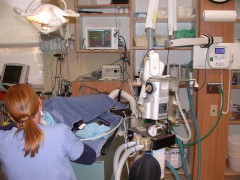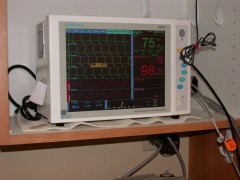 The idea of general anesthesia for their pet concerns many owners. While there is always some risk of complications when anesthesia is used, the safety of anesthesia depends primarily on the skill and training of the person responsible for the procedure. In veterinary medicine, this varies a great deal from practice to practice. In some practices, the lay staff performs all aspects of the anesthetic procedure, including selecting the drugs, selecting appropriate doses for the patient, and administering the drugs. While some technical staff do a good job with this, we feel that these functions are best done by a veterinarian. At Animal Dental Care, the doctor formulates the anesthetic protocol for each pet and personally monitors the anesthetic episode.
The idea of general anesthesia for their pet concerns many owners. While there is always some risk of complications when anesthesia is used, the safety of anesthesia depends primarily on the skill and training of the person responsible for the procedure. In veterinary medicine, this varies a great deal from practice to practice. In some practices, the lay staff performs all aspects of the anesthetic procedure, including selecting the drugs, selecting appropriate doses for the patient, and administering the drugs. While some technical staff do a good job with this, we feel that these functions are best done by a veterinarian. At Animal Dental Care, the doctor formulates the anesthetic protocol for each pet and personally monitors the anesthetic episode.

Anesthetic safety is greatly enhanced by all of the patient support and monitoring equipment utilized on every patient.
No one likes to see their pet have a “hangover” after an anesthetic episode. There are newer injectable and inhalation (gas) anesthetic agents that can significantly decrease the after-effects of anesthesia. These newer agents tend to be more expensive, but the patients “wake up” much faster. Other factors that make a big difference are the use of pre-anesthetic blood work to identify problems with your pet’s internal chemistry, the use of IV fluids during the procedure (can you imagine a person being anesthetized without an IV?), anesthetic monitoring that includes blood pressure and blood oxygenation, general patient care, keeping patients warm with warm-air blankets, warm-water blankets and IV fluid warmers, and attention to individual needs.

Modern anesthetic monitor showing current blood pressure, EKG, blood oxygenation levels, and patient temperature.
Many of our patients are 10-18 years of age and are ready to go home, acting normal, one to two hours after completion of a procedure lasting several hours. If managed properly, the anesthetic risks are very minimal. When considering anesthesia for your pet, ask questions about the type of anesthesia that will be used on your pet, how they will be monitored, and who will be administering the anesthesia. Also inquire about the anesthetic safety record of the facility where your pet will be anesthetized. We are happy to share our excellent safety record with clients.
